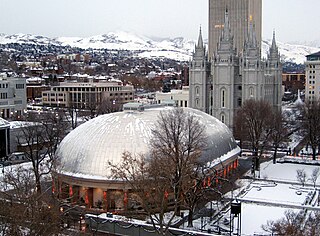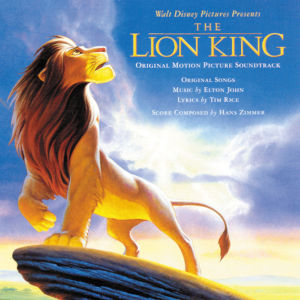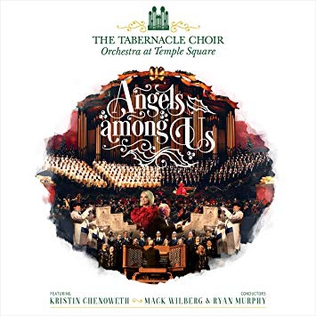
TheTabernacle Choir at Temple Square, formerly known as the Mormon Tabernacle Choir, is an American choir affiliated with the Church of Jesus Christ of Latter-day Saints. It has performed in the Salt Lake Tabernacle for over 100 years. Its weekly devotional program, Music & the Spoken Word, is one of the longest-running radio programs in the world, having aired every week since July 15, 1929.

The Salt Lake Tabernacle, formerly known as the Mormon Tabernacle, is located on Temple Square in Salt Lake City, in the U.S. state of Utah. The Tabernacle was built from 1863 to 1875 to house meetings for the Church of Jesus Christ of Latter-day Saints. It was the location of the church's semi-annual general conference until the meeting was moved to the new and larger LDS Conference Center in 2000. Now a historic building on Temple Square, the Salt Lake Tabernacle is still used for overflow crowds during general conference. It is renowned for its remarkable acoustics and iconic pipe organ. The Tabernacle Choir has performed there for over 100 years.

"Morning Has Broken" is a Christian hymn first published in 1931. It has words by English author Eleanor Farjeon and was inspired by the village of Alfriston in East Sussex, then set to a traditional Scottish Gaelic tune, "Bunessan".

Libera is an all-boy English vocal group founded by the late Robert Prizeman. Libera performs concerts in many countries, including the UK, the US and throughout Asia, and often makes recordings for their own album releases and other projects.

21 at 33 is the fourteenth studio album by British musician Elton John. It was released on 23 May 1980, through MCA Records in the US and The Rocket Record Company in all other territories. The album was co-produced by John and Clive Franks, and was primarily recorded in August 1979 at Super Bear Studios in Nice, France. The record was the first since Blue Moves (1976) to feature lyrics written by Bernie Taupin, while John also continued to experiment with other lyricists, including Gary Osborne and Tom Robinson. Contributors to the album include members of Toto and the Eagles, as well as Dee Murray and Nigel Olsson, marking their first appearance on an Elton John album since Captain Fantastic and the Brown Dirt Cowboy (1975).

Willennium is the second studio album by American rapper Will Smith. Recorded with a range of producers, including Poke & Tone and frequent collaborator DJ Jazzy Jeff, it was released on November 16, 1999, by Columbia Records. The album reached number 5 on the US Billboard 200 and was certified multi-platinum by the RIAA, making this Smith's second top ten album and second multi-platinum album following Big Willie Style in 1997. The album also reached the top ten on the UK Albums Chart, and was certified multi-platinum in that region and in other regions. "Wild Wild West", "Will 2K" and "Freakin' It" were released as singles.

"Praise You" is a song by British big beat musician Fatboy Slim. It was released as the third single from his second studio album, You've Come a Long Way, Baby (1998), on 4 January 1999. It reached number one on the UK Singles Chart and in Iceland, number four in Canada, number six in Ireland, and number 36 in the United States. As of 1999, it had sold over 150,000 units in the US.

These Are Special Times is the seventeenth studio album and sixth English-language album by Canadian singer Celine Dion, and also her first English-language Christmas album. It was first released in Europe on 30 October 1998, by Columbia Records. In the United States, it was released on 3 November 1998 through Epic Records. The album features cover versions of popular Christmas songs and original material, including "I'm Your Angel" and "The Prayer". Dion worked with David Foster and Ric Wake, who produced most of the album. These Are Special Times was released after two of Dion's most successful third and fourth English albums, Falling into You (1996) and Let's Talk About Love (1997).

The Lion King: Original Motion Picture Soundtrack is the soundtrack album for the eponymous Disney film. It contains songs from the film written by Elton John and Tim Rice, and a score composed by Hans Zimmer. Elton John has a dual role of performer for several tracks. Additional performers include Lebo M, Carmen Twillie, Jason Weaver, Rowan Atkinson, Joseph Williams, Whoopi Goldberg, Jeremy Irons, Cheech Marin, Jim Cummings, Nathan Lane, Ernie Sabella, and Sally Dworsky. The album was released on May 31, 1994, on CD and audio cassette. The soundtrack was recorded in three different countries: the U.S., the U.K. and South Africa. It is the best-selling soundtrack album to an animated film in the United States with over 7 million copies sold, with 4,934,000 copies sold in 1994. Hans Zimmer was awarded an Academy Award for Best Original Score at the 67th Academy Awards in 1995. An expanded version of The Lion King soundtrack, featuring 30 minutes of previously unreleased material, was released as part of the Walt Disney Records: The Legacy Collection series on June 24, 2014. In 2014, Hot Topic released a vinyl picture disc of the soundtrack.
Hymns are an important part of the history and worship of the Church of Jesus Christ of Latter-day Saints.
Merrill Boyd Jenson is an American composer and arranger who has composed film scores for over thirty films including Emma Smith: My Story, Joseph Smith: Prophet of the Restoration, The Testaments of One Fold and One Shepherd, Legacy, Harry's War, and Windwalker. Many of the films Jenson composed music for were directed by Academy Award-winning director Kieth Merrill. Jenson has also composed several concert productions including a symphony that premiered at Carnegie Hall. Additionally, he has composed music for many television commercials including the acclaimed Homefront ads, music for three outdoor pageants, and several albums. Jenson lives in Provo, Utah with his wife Betsy Lee Jenson.

Hard Workin' Man is the second studio album by American country music duo Brooks & Dunn. Like its predecessor, Brand New Man, the album had a string of top 5 hits on the US Hot Country chart. Its singles were "Hard Workin' Man" (#4), "Rock My World " (#2), "She Used To Be Mine" (#1), "We'll Burn That Bridge" (#2), and "That Ain't No Way To Go" (#1). The album also featured a remixed dance version of the country number-one hit "Boot Scootin' Boogie", from the previous album.
The Mormon Youth Symphony and Chorus (MYSC) was an official musical organization of the Church of Jesus Christ of Latter-day Saints from 1969 to 1999, composed of young musicians aged 18 to 33. In its 30-year history, MYSC was credited with many television specials, numerous recordings, concerts, and several major tours throughout the United States. The group was disbanded during the 1999 reorganization of the Tabernacle Choir and resulting creation of the Orchestra at Temple Square. The choral arm of the group provided music for the church's annual and semi-annual general conferences, usually during the Saturday morning sessions.

Sing, Choirs of Angels! is a Christmas album released by Mormon Tabernacle Choir. The album was originally released in 2004. It became the first choir recording to make Billboard Magazine's Top 25 Christian chart.
The 27th Annual GMA Dove Awards were held on April 25, 1996 to recognizing accomplishments of musicians for the year 1995. The show was held at the Grand Ole Opry House in Nashville, Tennessee, and was hosted by Michael W. Smith.

Samuel Frederick Smith is an English singer and songwriter. In 2012, they rose to prominence when they featured on Disclosure's breakthrough single "Latch", which peaked at number eleven on the UK Singles Chart. The following year, they featured on Naughty Boy's single "La La La", which became a number one single in the UK.
Hezekiah Xzavier Walker Jr. is an American gospel music artist and the pastor of Love Fellowship Tabernacle in Brooklyn, New York. Walker has released several albums on Benson Records and Verity Records as Hezekiah Walker & The Love Fellowship Crusade Choir.
Joseph W. Pace II is an American gospel musician. He started his music career in 1996, with Colorado Mass Choir. They have released 14 albums with 11 of them charting on the Billboard magazine Gospel Albums chart. Pace has released albums with several record labels including Zomba Records, Verity Records, Alliant Records, Word Records, Epic Records, Integrity Music, Columbia Records, NuSpring Music, Sony Music, and Tyscot Records.

The Getaway is the eleventh studio album by American rock band Red Hot Chili Peppers, released through Warner Bros. on June 17, 2016. The band's first studio album since 2011's I'm with You, it was produced by Danger Mouse, who replaced Rick Rubin after 25 years and six albums as the band's producer. This is the band's second and final album with guitarist Josh Klinghoffer before the return of John Frusciante in 2019, with Rubin also returning soon thereafter.

Angels Among Us was recorded during The Tabernacle Choir at Temple Square's 2018 Christmas shows in the LDS Conference Center, featuring vocalist Kristin Chenoweth. An album and concert DVD was released on October 12, 2019. The recorded concert was broadcast on PBS and KUED on December 16, 2019 and BYUtv beginning on December 19, 2019.














